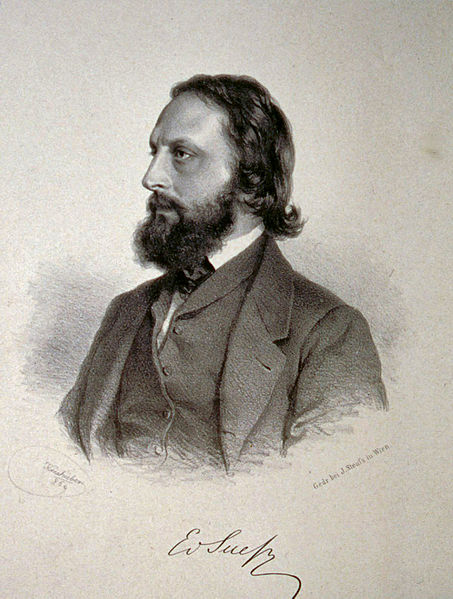
Eduard Suess (1831-1914)
On August 20, 1831, Austrian geologist Eduard Suess was born. Suess was an expert on the geography of the Alps and helped lay the basis for paleogeography and tectonics, i.e. the study of the architecture and evolution of the Earth‘s outer rocky shell. He is responsible for hypothesising two major former geographical features, the supercontinent Gondwana (proposed in 1861) and the Tethys Ocean.
An Early Interest in Geology
Eduard Suess was born in London into the large family of the Saxon Protestant merchant Adolph Sueß (1797-1862) and his wife Eleonore Friederike Zdekauer (1806-1884). When he reached the age of three, the family first moved to Prague, where more siblings were born, and 11 years later to Vienna. Already at a young age he was interested in geology and at the age of 19, as an assistant in the “Hofmuseum” in Vienna, published his first paper on the geology of Karlovy Vary.
Unusual Academic Career
In 1857 – without a doctorate or habilitation – Suess was appointed professor at the University of Vienna, first for palaeontology, 1862 for geology. In addition to his activities as a university professor, he was also active as a politician in the Vienna City Council and as a member of the Liberal Party in the Lower Austrian Parliament. In these functions he primarily operated the Vienna Danube regulation and the construction of the I. Vienna flood water pipeline. For this reason he also received the honorary citizenship of Vienna, at that time still predominantly reserved for the nobles.
The Origin of the Alps
Since 1857 Suess gradually began to develop his theses on the origin of the Alps. In further development of the geosynclinal theory of the North American James Dwight Dana, he came to the conclusion that the Alps were essentially formed by slow lateral constriction movements of the earth’s crust, such as folding and overthrust, in this case an asymmetric movement of the rock layers towards the north. As a driving force, he accepted, like Dana, the shrinkage of the earth’s crust by cooling the earth’s body. Until then, European geologists, following James Hutton [5] and Since 1857 he gradually began to develop his theses on the origin of the Alps. In further development of the geosynclinal theory of the North American James Dwight Dana, he came to the conclusion that the Alps were essentially formed by slow lateral constriction movements of the earth’s crust, such as folding and overthrust, in this case an asymmetric movement of the rock layers towards the north. As a driving force, he accepted, like Dana, the shrinkage of the earth’s crust by cooling the earth’s body. Until then, European geologists, following James Hutton and Leopold von Buch,[4] had mostly believed that the mountain ranges were rising from the ground mainly due to vertical volcanic forces. However, Suess regarded volcanism more as a consequence of mountain building (orogenesis) than as its cause. He explained the asymmetry of the mountain ranges by the slipping of the rock layers onto the sunken foothills., had mostly believed that the mountain ranges were rising from the ground mainly due to vertical volcanic forces. However, Suess regarded volcanism more as a consequence of mountain building (orogenesis) than as its cause. He explained the asymmetry of the mountain ranges by the slipping of the rock layers onto the sunken foothills.
Elevator Tectonics
Since 1878, Suess attempted a large-scale summary of the geological knowledge of his time, looking at the entire shape of the oceans and continents with their mountain ranges. Charles Lyell‘s old “elevator tectonics” (slow ups and downs of the mainland masses, with correspondingly slow erosion and flooding) he considered unsuitable, since his occupation with the complex tectonics of the Alps.[6] Instead, he tried to connect his tectonic model with the evolutionary history of the earth, as it had been handed down in sedimentary rocks all over the world. Suess assumed that the collapse of an ocean basin would cause the sea level to sink worldwide (regression). This then leads to an increased erosion of the exposed lands, which in turn leads to an increased input of sediments into the oceans until they are filled, and finally to a renewed rise in sea level (transgression). With the introduction of the concept of eustatic sea level fluctuations, which is still in use today, he provided a plausible explanation as to why various geological units, such as Jurassic, Cretaceous, etc., are formed in a similar form worldwide and can be correlated with one another.
Supercontinent Gondwana
On the basis of such considerations, Suess concluded that Africa and Europe were once closely linked and that the northern Alps had once been the bottom of an ocean of which the Mediterranean was only a remnant. Although large parts of this thesis are no longer accepted today (among other things because the theory of plate tectonics had not yet been developed at Suess’ time), he was so close to the facts with this thesis that the discovery of the Tethys ocean, to which he gave this name in 1893, is attributed to him. Among his other important discoveries is that a certain fern species Glossopteris can be found in fossils of South America, Africa and India (at this time Suess could not have known that this fern species was also found in Antarctic fossils). His explanation for this fact was that these three continents had once been united as a “supercontinent“. He called it “Gondwana” (as much as “Land of the Gond”). In doing so, he contradicted the prevailing opinion up to that time that identical or closely related species had migrated from one continent to another over straits like those of Panama. He believed that the crust between these continents had sunk in the course of the Tertiary, i.e. that the land bridges had previously identified entire continents. He was not yet aware of the fact that the land masses drifted apart, but was the first to understand that the East African trench must have developed due to lateral expansion movements, which led to thinning of the earth’s crust and to the formation of a trench fracture.
In 1885, Eduard Suess published “Das Antlitz der Erde” (The Face of the Earth) as a comprehensive synthesis of his ideas. For many years, this successful and influential work was a popular textbook. In Suess work on the Face of the Earth, the author further introduced the concept of the biosphere, which was later extended by Vladimir I. Vernadsky in 1926.[7] In 1895, Eduard Suess was elected a member of the Royal Swedish Academy of Sciences. Eduard Suess was awarded the Wollaston Medal of the Geological Society of London in 1896 for his services to geology. The Suessgletscher in East Antarctic Viktorialand, Mount Suess in the Transantarctic Mountains and the Moon Crater Suess were named after him.
David Bercovici, On the Origin of Plate Tectonics, [10]
References and Further Reading:
- [1] Eduard Suess at Wien Geschichte Wiki [in German]
- [2] Eduard Suess at Britannica Online
- [3] Eduard Suess at the National Academy of Sciences
- [4] Christian Leopold von Buch and the Jurassic System, SciHi Blog
- [5] James Hutton – the Father of Modern Geology, SciHi Blog
- [6] Charles Lyell and the Principles of Geology, SciHi Blog
- [7] Vladimir Vernadsky and the Biosphere, SciHi Blog
- [8] Works by or about Eduard Suess at Internet Archive
- [9] Eduard Suess at Wikidata
- [10] David Bercovici, On the Origin of Plate Tectonics, AGU @ youtube
- [11] Schuchert, C (June 1914). “Eduard Suess”. Science. 39 (1017): 933–935.
- [12] Gregory, John Walter (29 June 1905). “Review of The Face of the Earth (Das Antlitz der Erde) by Eduard Suess, trans. by H. B. C. Sollas, vol. i, 1904″. Nature. 72 (1861): 193–194.
- [13] Sueß, Eduard in Constant von Wurzbach, Biographisches Lexikon des Kaiserthums Oesterreich 40. Band, Seite 278, Wien, k. k. Hof- und Staatsdruckerei 1880
- [14] Timeline for Eduard Suess, via Wikidata





